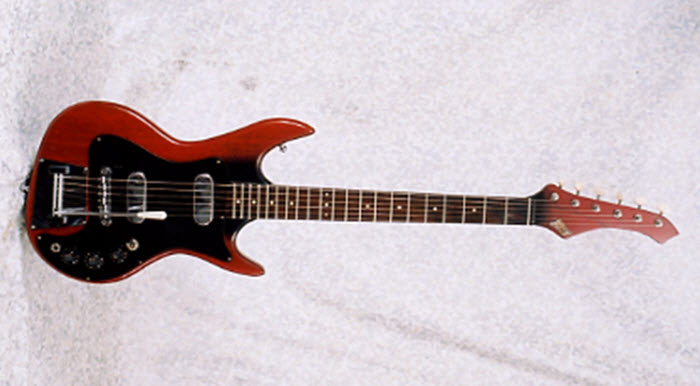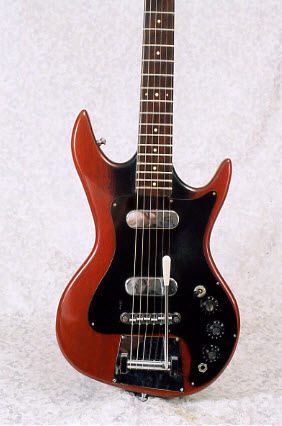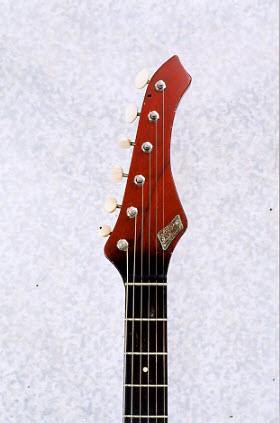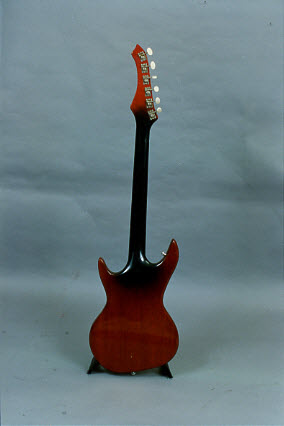
If you’ve read even a little of my writing about guitars over the years, you know I’m fatally attracted to unusual guitars. There’s a reason I’m “The Different Strummer.” But even I have to admit some guitars are just plain ugly. A case in point: the Fenton-Weill Tux-master from England, a country (sorry, friends) that has more than its share of these birds.

Vintage 1961 Fenton-Weill Tux-Master Electric Guitar
This Tux-master actually comes with a pretty impressive pedigree. In 1959 the legendary guitar-designer (and notoriously bad businessman) Jim Burns hooked up with a German chap named Henry Weill to build a line of Burns-Weill electric solidbody guitars built in London. Weills was reportedly the electronics expert. This partnership lasted less than a year and it’s pretty hard to find examples. However, it’s pretty reasonable to speculate that Burns and Weill met more than once over many more than one pint! Then they retired to a band saw to reshape some firewood. These were truly Bizarro guitars, squarish angular monsters all off-balance!
According to online sources (meaning cross your fingers and hope), one of their models was called the Fenton, and that became the source of name of the new company re-formed by Weill in 1960, Fenton-Weill. Whether or not there was a person named Fenton remains one of guitardom’s unsolved mysteries.

Vintage 1961 Fenton-Weill Tux-Master Electric Guitar
Regarding this Fenton-Weill guitar I have in my notes that it was a re-design of the Burns-Weill RP2G guitar model but I have no idea how I arrived at such a conclusion. I don’t need to point out this guitar’s ungainly aspects! That anteater snout headstock, the small, asymmetrical body.
To be fair, this guitar actually has some innovative features. For one thing, the neck is glued in and has a heelless design to improve access up the neck. This is at least a decade in advance of the appearance of that design feature in the U.S. Also, the weird paint job, with the shaded black-burst, was at least 25 years ahead of its time, such aesthetics not appearing until the mid-1980s.

Vintage 1961 Fenton-Weill Tux-Master Electric Guitar
Actually, this guitar isn’t entirely “stock.” The bridge is a Gotoh replacement and the 3-way switch and jack are not original. However, this kind of fits with the gestalt of Fenton-Weills. That’s because Henry Weill was also an early pioneer in sourcing parts from Japan, as it turns out (if online sources are to be believed). Apparently Weill bought pre-assembled pickguards, with pickups and wiring, from Guyatone. Reportedly, Henry “tweaked” them, but the electronics are Japanese. Online rumors suggest that Weill didn’t do the wood-work either. Necks are supposed to have come from Germany. Thus, the presence of a Gotoh bridge doesn’t violate the spirit of the law.
Like most ugly-duckling guitars, this actually plays and sounds pretty well. The original Featherlite vibrato is great for your rendition of Apache or Walk, Don’t Run. I suspect you wouldn’t want to be seen strapping this on for a heavy metal gig, but it does have a cool surf vibe.
When Burns and Weill split in 1959, Weill continued to make guitars badged Weill-London. These seem to be even rarer than Burns-Weill guitars. I couldn’t find a single online image of one, but they no doubt continued the same aesthetic. The Fenton-Weill brand was in play at least by 1963. Weill had his own factory by this time and was also producing amplifiers, plus reportedly producing guitars for Hohner and Selmer.

Vintage 1961 Fenton-Weill Tux-Master Electric Guitar
If you Google-Image Fenton-Weill guitars you’ll get a range of designs that include the square Bizarros some vaguely Supro-ish LPs, a kind of Alamo Jazzmaster thing, and these skinny anteater whatever-they-ares. Some have bolt-on necks, many are set-necks like this. Guitars and basses. The black-bursty finish touches are fairly tyoical.
Fenton-Weills seem to have come in a plethora of model names, “-master” being favored, including Dualmaster and Twinmaster. Minor details differ between models. Consistency was no hobgoblin for Fenton-Weill!
Alas, Henry Weill doesn’t appear to have been much better at business than Jim Burns and in 1965 the Fenton-Weill company was history, imploding in bankruptcy.
I can’t be certain when this guitar was made, but the window is pretty tight: the widest being 1960-65, with 1962-65 being more likely.
Today, sourcing parts from foreign lands is common practice. It was novel when this guitar was made, as were many of the other features. The awkward design, however, is completely original and completely…ugly! So ugly you gotta love it! I know I do…

Hi- few incorrect bits of info in here.
First- the guitar is actually named ‘Dualtone’ and was a new design, not related to the Burns Weill models (most of which can be seen with a google). Tuxmaster rings a bell though…was it renamed as that in Sweden or something?
Secondly- the electrics were 100% British- pickups made in the UK, lesa and radiospares pots etc
My first guitar was a Guayatone LG50 played through a Fenton-Weill 20W head and cab with 12″ speaker. I believe they also made an amp where the amp head could be stored in the cabinet for travel – now that’s a great idea !!!
Hey there! Is this for sale !?.
I have a Fenton Weill guitar for sale if you are interested. I recently took it to a Luther and had it overhauled. He said it was great. I had it given to me in 1983 as a gift from a guy I had done a summer season with.
Call me on 07976 202605 (Roger) if you are interested – Wolverhampton
It reminds me of something that a character from a Tim Burton movie would be sporting. ..I’m thinking from Betelgeuse, The Nightmare Before Christmas or the Corpse Bride…along those Burtonish lines. It looks to have been built about the same time I fancy Brian May and his father were constructing Brian’s first and now world famous ax…except we could christen this one the Red -Not So- Special.
Just as a matter of interest, the Fenton Weill Dualtone was also sold as the “Dallas Tuxedo 61” in the early 60s, though it was a completely different design to the original Dallas Tuxedo.
I found one in a second-hand shop in excellent condition and complete with its original hard case (around 20 years ago).
At the time of purchase I was not aware that it had previously been sold as a Fenton Weill Dualtone, but recognised that it was related to the Burns Sonic and Artist models which I was interested in (being a Burns fan). The heelless set neck and the small mahogany body and mahogany neck were give-aways. Also, the 3 dot inlays at the 12th fret, the zero fret and the Van Gent machine heads!
I have to agree that the headstock shape is rather “unusual” – but I love the “pointy” horns (reminiscent, to some extent, of the later Burns Artist and Bison models).
It has to be said that these guitars were somewhat “crude” by comparison to Gibson and Fender products of the time, but they were anything but ordinary or boring – which is, after all, why they still command great interest today!
Think the knobs are replacements on this example too, and the smaller white scrarchplate/pickguard that sits on top of the black one’s missing too.
Hello I just found one of these that my Brother had in his collection of many GUITARS!Looking to sell it but can’t seem to find any reference to its value I’m sure it’s pretty valuable these are very rare ! So if anybody is interested in purchasing this guitar my number is 208-501-6580 Thank You
Hello I just came across one of these and I’m not sure of the value this one’s a 1961 tuxmaster and I’m looking to sell this this is a very rare guitar I can’t seem to find a price for what it’s worth I can be reached at 208-501-6580
I’ve got what was described to me as a Fenton Weill, it’s a Red body and missing a bridge, can’t find a similar one on line anywhere – how do I identify this enigmatic instrument ?!!
Have a Fenton Weil guitar made in the 1960